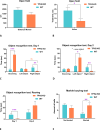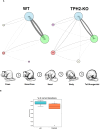Trace amine-associated receptor 1 agonist reduces aggression in brain serotonin-deficient tryptophan hydroxylase 2 knockout rats
- PMID: 39748904
- PMCID: PMC11693706
- DOI: 10.3389/fpsyt.2024.1484925
Trace amine-associated receptor 1 agonist reduces aggression in brain serotonin-deficient tryptophan hydroxylase 2 knockout rats
Abstract
Introduction: Aggression and self-harm disproportionately occur in youths preoccupied with social status tracking. These pathological conditions are linked to a serotonin (5-HT) deficit in the brain. Ablation of 5-HT biosynthesis by tryptophan hydroxylase 2 knockout (TPH2-KO) increases aggression in rodents. Remarkably, deletion of the trace amine-associated receptor 1 (TAAR1) results in the same consequences. Unlike the nuanced dynamics of social status cues in young people, the social ranks of rats mainly advance when they dominate larger opponents in combat.
Methods: This study explored whether the potent TAAR1 agonist RO5263397 reduces aggression caused by 5-HT depletion, and whether social rank advancement motivates this aggression. The resident-intruder paradigm was applied with larger and smaller intruders to evaluate whether social rank advancement motivates aggressive behaviors in TPH2-KO rats.
Results: When a smaller intruder was introduced, 5-HT-deficient rats did not differ from wild type littermates. However, when the intruders were larger, the mutants extended their aggressive efforts, refusing to submit. Importantly, RO5263397 selectively abolished this abnormal form of aggression in TPH2-KO rats.
Discussion: Results supported social rank advancement as the main incentive. These data also suggest that TAAR1 is a promising target for the development of new treatments for aggression; independent data also support this conclusion.
Keywords: 5HT; RO5263397; TAAR1; TAAR1 agonist; TPH2; aggression; serotonin; social dominance.
Copyright © 2024 Zhukov, Alnefeesi, Krotova, Nemets, Demin, Karpenko, Budygin, Kanov, Kalueff, Shabanov, Bader, Alenina and Gainetdinov.
Conflict of interest statement
The authors declare that the research was conducted in the absence of any commercial or financial relationships that could be construed as a potential conflict of interest. The author(s) declared that they were an editorial board member of Frontiers, at the time of submission. This had no impact on the peer review process and the final decision.
Figures





Similar articles
-
Enhanced aggressive phenotype of Tph2 knockout rats is associated with diminished 5-HT1A receptor sensitivity.Neuropharmacology. 2019 Jul 15;153:134-141. doi: 10.1016/j.neuropharm.2019.05.004. Epub 2019 May 9. Neuropharmacology. 2019. PMID: 31078489
-
TAAR1 and 5-HT1B receptor agonists attenuate autism-like irritability and aggression in rats prenatally exposed to valproic acid.Pharmacol Biochem Behav. 2024 Dec;245:173862. doi: 10.1016/j.pbb.2024.173862. Epub 2024 Aug 26. Pharmacol Biochem Behav. 2024. PMID: 39197535
-
Enhanced Aggression, Reduced Self-Grooming Behavior and Altered 5-HT Regulation in the Frontal Cortex in Mice Lacking Trace Amine-Associated Receptor 1 (TAAR1).Int J Mol Sci. 2022 Nov 15;23(22):14066. doi: 10.3390/ijms232214066. Int J Mol Sci. 2022. PMID: 36430544 Free PMC article.
-
5-HT1A and 5-HT1B receptor agonists and aggression: a pharmacological challenge of the serotonin deficiency hypothesis.Eur J Pharmacol. 2005 Dec 5;526(1-3):125-39. doi: 10.1016/j.ejphar.2005.09.065. Epub 2005 Nov 28. Eur J Pharmacol. 2005. PMID: 16310183 Review.
-
Targeting brain serotonin synthesis: insights into neurodevelopmental disorders with long-term outcomes related to negative emotionality, aggression and antisocial behaviour.Philos Trans R Soc Lond B Biol Sci. 2012 Sep 5;367(1601):2426-43. doi: 10.1098/rstb.2012.0039. Philos Trans R Soc Lond B Biol Sci. 2012. PMID: 22826343 Free PMC article. Review.
Cited by
-
Role of Glial Trace Amine Associated Receptor 1 (TAAR1) and Microbiota in Schizophrenia.Neurochem Res. 2025 Aug 21;50(5):273. doi: 10.1007/s11064-025-04525-5. Neurochem Res. 2025. PMID: 40839091 Review.
-
Central Serotonin Deficiency Impairs Recovery of Sensorimotor Abilities After Spinal Cord Injury in Rats.Int J Mol Sci. 2025 Mar 19;26(6):2761. doi: 10.3390/ijms26062761. Int J Mol Sci. 2025. PMID: 40141402 Free PMC article.
-
Tryptophan hydroxylase 2 deficiency alters autism-related behavioural phenotypes in rats.Sci Rep. 2025 Jul 1;15(1):20522. doi: 10.1038/s41598-025-05684-9. Sci Rep. 2025. PMID: 40594285 Free PMC article.
References
LinkOut - more resources
Full Text Sources
Research Materials

